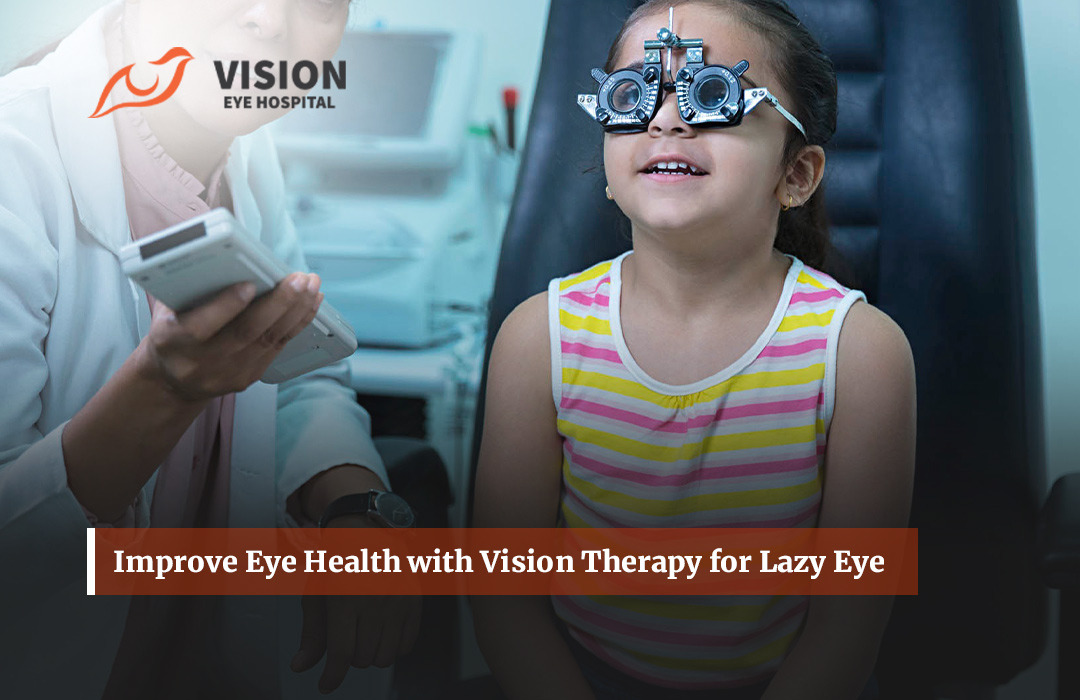- Doctors
- Patients Care & Health Info
-
Services
- Education & Fellowships
- Myopia Clinic & Lasik Center
- View Prescription

Sep 2025
Lazy eyes can feel frustrating, especially when it affects daily life or your child’s confidence. That’s where Vision Therapy comes in—a proven way to train the eyes and brain to work together. Think of it as “eye gym” for amblyopia, where guided exercises slowly strengthen the weaker eye. From simple games to structured amblyopia vision therapy exercises, this approach works for both kids and adults. If you’ve ever wondered how to fix lazy eyes in adults or if eye therapy for amblyopia really helps, you’re in the right place. In this guide, we’ll walk through what Vision Therapy is, how it works, and why it could be the fresh start your eyes have been waiting for.
Amblyopia, often called lazy eye, is when one eye does not see as well as the other. The eye may look normal, but the brain favors the stronger eye. Over time, the weaker eye gets ignored, and vision drops.
This can happen for many reasons. Some children are born with crossed eyes, known as strabismus. Others may have more power in one eye, so the brain chooses the clearer signal. In some cases, injury or eye problems at birth can lead to it.
The good news is that lazy eye can be treated. Kids respond best because their brains are still growing. But adults can also improve with the right care. Modern treatments like Vision Therapy for Amblyopia use special eye therapy for amblyopia to train the brain again. With fun and simple amblyopia vision therapy exercises, even adults can learn how to fix lazy eyes in adults.
Think of Vision Therapy as a workout plan for your eyes. Just like physical therapy helps weak muscles, this is like “physical therapy for the eyes.” It uses guided activities to train the brain and eyes to work better together.
When it comes to Vision Therapy for Amblyopia, the goal is simple: help the weaker eye wake up and start pulling its weight. Unlike quick fixes, this therapy is done step by step, with the help of eye care professionals. It’s safe, non-surgical, and tailored for each person.
Lazy eye is not just an eye problem-it’s a brain-eye teamwork issue. With eye therapy for amblyopia, the brain learns to use signals from the weaker eye again. Over time, the brain builds new connections, making vision sharper.
This is different from glasses or patching alone. Glasses can fix clarity. Patching forces the weaker eye to work. But Vision Therapy combines these with exercises that actually re-train the brain. It’s like fixing the system, not just the symptom.
The fun part? Many amblyopia vision therapy exercises feel like games. Kids often enjoy them, and adults find them engaging too.
Eye patch games: Reading short stories, coloring, or solving puzzles while the strong eye is patched.
Digital therapy: Computer or tablet games designed to improve eye teaming.
Hand-eye tasks: Catching a ball, stacking blocks, or tracing shapes.
These simple steps slowly build focus, balance, and teamwork between the eyes.
A common question is, “How to fix lazy eyes in adults?” The answer is: yes, improvement is possible. For a long time, people believed treatment only worked for kids. But new studies show adults can benefit too, thanks to brain plasticity-the brain’s ability to change and adapt, even later in life.
Adults may need more time and consistency, but progress happens. Many report sharper vision, better depth perception, and greater comfort after sticking with therapy. It’s never too late to give your eyes a chance.
It might be tempting to try eye exercises on your own, but self-treatment is risky. A lazy eye is not the same in every person. Some cases are mild, others are complex.
That’s why an optometrist or ophthalmologist should guide the process. They can design a plan that matches your needs, track progress, and adjust exercises as needed. Think of them as a coach-you’ll get better results with expert support.
The gains are more than just medical. With Vision Therapy for Amblyopia, people often notice:
Better sight: The weaker eye becomes sharper and more active.
Stronger teamwork: Both eyes start working together, improving depth and balance.
Confidence boost: Clearer vision brings ease in reading, sports, and daily tasks.
Safe and natural: No surgery, just guided practice and patience.
It’s honest to say Vision Therapy is not magic. Results take time and steady effort. Some cases may not improve as much as others. But even small gains can make life easier.
A big myth is that only kids can benefit. That’s not true. Adults can also see progress with the right program. Another myth is that therapy is boring—it’s not. When done right, many exercises are fun and interactive.
Lazy eyes can feel discouraging, but it doesn’t have to be permanent. With Vision Therapy, both kids and adults have a chance to improve vision and build confidence.
If you or your child struggles with amblyopia, don’t wait. Talk to a trusted eye specialist about starting eye therapy for amblyopia. A guided plan of amblyopia vision therapy exercises may be the fresh start your eyes need. Remember, it’s never too late to train your eyes and brain to see better.
John Doe
10 days agoLorem ipsum dolor, sit amet consectetur adipisicing elit. Perferendis cum illum facere in exercitationem assumenda corporis itaque excepturi molestias voluptas, quibusdam accusantium, quae dolore iste eum aliquam saepe eius iure.
John Doe
10 days agoLorem ipsum dolor, sit amet consectetur adipisicing elit. Perferendis cum illum facere in exercitationem assumenda corporis itaque excepturi molestias voluptas, quibusdam accusantium, quae dolore iste eum aliquam saepe eius iure.